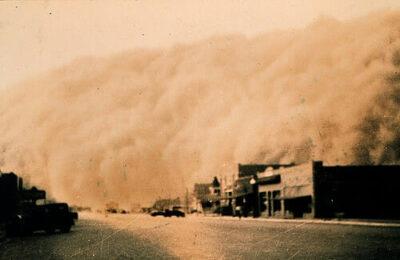A severe drought on the Great Plains might be stirring up a new Dust Bowl. A giant cloud of dust that swept through Midland, Texas, on April 4 reminded many of the greatdust storms of the 1930s.
Video of the storm from TV station CW39 looks like a 1930s newsreel with dust blotting out the sun and covering the horizon. Most of West Texas has been affected by severe and extreme drought, The University of Nebraska’s Drought Monitor indicates. A small portion of Texas is in the highest level of exceptional drought.
The Dust Bowl, a man-madedisaster caused by a decade of drought, covered the same region. A NewsOK map indicates this. The Dust Bowl, or Dirty Thirties, was a series of severe dust storms, or Black Blizzards, that covered the Great Plains of the U.S. and Canada between 1934 and 1940.
The Dust Bowl developed because of a severe drought on the Great Plains between 1934 and 1940. The drought turned soil, which had been stirred up by decades of farming, to dust. The National Weather Service reported that a drought in the Northern Plains is expanding rapidly.
How The Dust Bowl Can Return
The situation was made worse by decades of government policies that encouraged thousands of families to farm in areas where it was not economically viable.
Through plowing, farmers destroyed the vegetation that had prevented erosion. When they stopped planting because of low crop prices the Dust Bowl developed.
If the drought continues and economic conditions such as falling Chinese demand for American crops like soybeans, cause farmers to stop planting, Dust Bowl conditions can return. The Chinese government put a 25% tariff on soybeans in retaliation for U.S. tariffs on steel and aluminum in March. Some observers think that the tariffwill hurt U.S. farmers by encouraging the Chinese to buy their soybeans from countries like Brazil.
A partial cause of the Dust Bowl was the Smoot-Hartley Tariff Act of 1930 that triggered a trade war which destroyed American crop prices. Smoot-Hartley caused U.S. trade with Europe, including agricultural exports, to fall by two-thirds between 1929 and 1932. That literally destroyed the farm economy and helped create the Dust Bowl.
How To Survive A Severe Dust Storm
History teaches us that some areas of the plains might experience severe dust storms in the near future.
Here are some tips for surviving severe dust storms.
- The most significant danger from dust storms is damage to your respiratory system, especially your lungs. Records indicate 33 people died from respiratory problems caused by the Dust Bowl in a month at a hospital in Meade, Kansas in 1935.
You can protect your lungs with a sanding and woodworking respirator like those worn by painters and construction workers. Have at least one respirator available for everybody in your household. Wear masks inside as well as outside because dust can get through tiny cracks.
It is also a good idea to keep a respirator in your vehicle in case you run into a dust storm while driving. You can buy 15 packs of sanding and woodworking respirators from retailers like Amazon and the Home Depot for as little as $21. Put the respirator on as soon as you see the dust coming.
- Protect your eyes. Dust can very quickly do a lot of damage to your eyes.
Make sure you have a pair of safety goggles or ski goggles for everybody in your household. In order to work, the goggles will have to cover the eyes completely and touch the skin.
Goggles with a strap are best because they will not fall off. If you wear glasses, make sure the goggles will cover them. Standard eyeglasses will not protect you from blowing dust. The cheap safety glasses you can order online should protect your eyes from a dust storm.
- Cover up. If you have to go outside in a dust storm, all of your skin should be covered. Wear long pants and long-sleeved shirts or jackets, and cover your head with a bandana, hood, or mask. Wear a respirator but make sure your face and ears are covered.
- Stay put. If you see a dust storm coming, get inside if possible. If you are driving, park your vehicle and wait it out. If you have to stay outside, find a place where are you not exposed to oncoming wind and stay there.
- Don’t drive in a dust storm. Low visibility can lead to accidents in a Black Blizzard. If you see a dust cloud in the distance, get off of freeways or busy highways because dust storms have caused massive pileups on highways in states like Arizona. Simply pulling over and waiting the storm out can save your life.
- Consider adding an air purifier for dirt and dust to your home’s ventilation system. There are filters built for dust storms. You will most likely need to shop around and pay extra for one. Such a system is a good investment if anybody in your home has respiratory problems or allergies.
All Americans and Canadians need to prepare because Dust Bowl-like conditions might soon be returning to the Great Plains and other regions.
